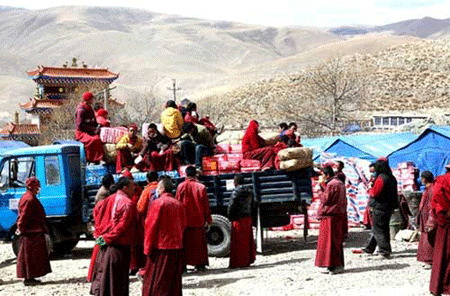
The five-colored Buddhist banners were flying high on the sacred Qinghai-Tibetan Plateau and the magneta robe looked so striking in the sun. At the seat of the Yushu Autonomous Prefecture, the rescue workers could be seen everywhere across the debris.
An every corner of the site, as long as there was a ruined site, there would be rescuers dressed in orange, white and green.
Among the relief force, there was an important mission team in brown cassocks, who were lamas from the lamaseries of Tibet, Sichuan and Qinghai. They were a “special team” among all relief forces.
April 19th was the 5th day after the catastrophic Yushu earthquake. The relief workers and donated supplies flowed into the quake zone incessantly from all over the country.
The magnificent Jiegu Lamasery and the lamas looked very eye-catching. Early in the morning, I entered the Jiegu Temple at an altitude of 4000 meters to find how the lamas spent a day.
The Jiegu Lamasery located in Mount Dong Pengcuodaze in Jiegu Township with a history of 2000 years is the major temple of the famous Sagya school of the Tibetan Buddhism in the north of Yushu.
The temple was built on the slope of the mountain with well-arranged buildings and halls. Therefore, it is famous for its magnificent temples, great number of lamas and scholars, and rich cultural relics.
During its most prosperous period, the number of lamas reached as many as over a thousand. On December 1, 1937 of the Tibetan calendar, the 9th Panchen Qoigyi Nyima attained his nirvana at the temple on his way back to Tibet.
Director of the Temple Administrative Committee Phurbu said that monks started off as soon as the earthquake happened. In the quake-ravaged area, monks in cassocks could be seen everywhere.
They took part in digging and rescuing survivors, delivering and distributing relief supplies and food, hosting soul releasing ceremony for the dead at their cremation and so on.
It fully demonstrated that their patriotism and enthusiasm for their religion and the people was not just a lip service. The relief work is a good deed. Universal Salvation requires the action of monks.
In the monastery, the monks took turns to guard the monastery; on the streets, they put up big pots to offer food for free to the people in the quake area; On the resettlement sites, they were delivering vegetables;
On the open space, monks were busy with transporting food and other supplies donated from all parts of the country;
On the way to the suburb, monks drove their trucks to deliver food to the victims; In the tents, Monk Nyima Tsering and other monks were chanting Buddhist scriptures by praying.
Danba Dolma and Pashang Kamkar, the two sisters who came to the temple in 2005 were in charge of lighting up butter lamps to pray for the dead and the livings during the quake.
Source : http://chinatibet.people.com.cn




